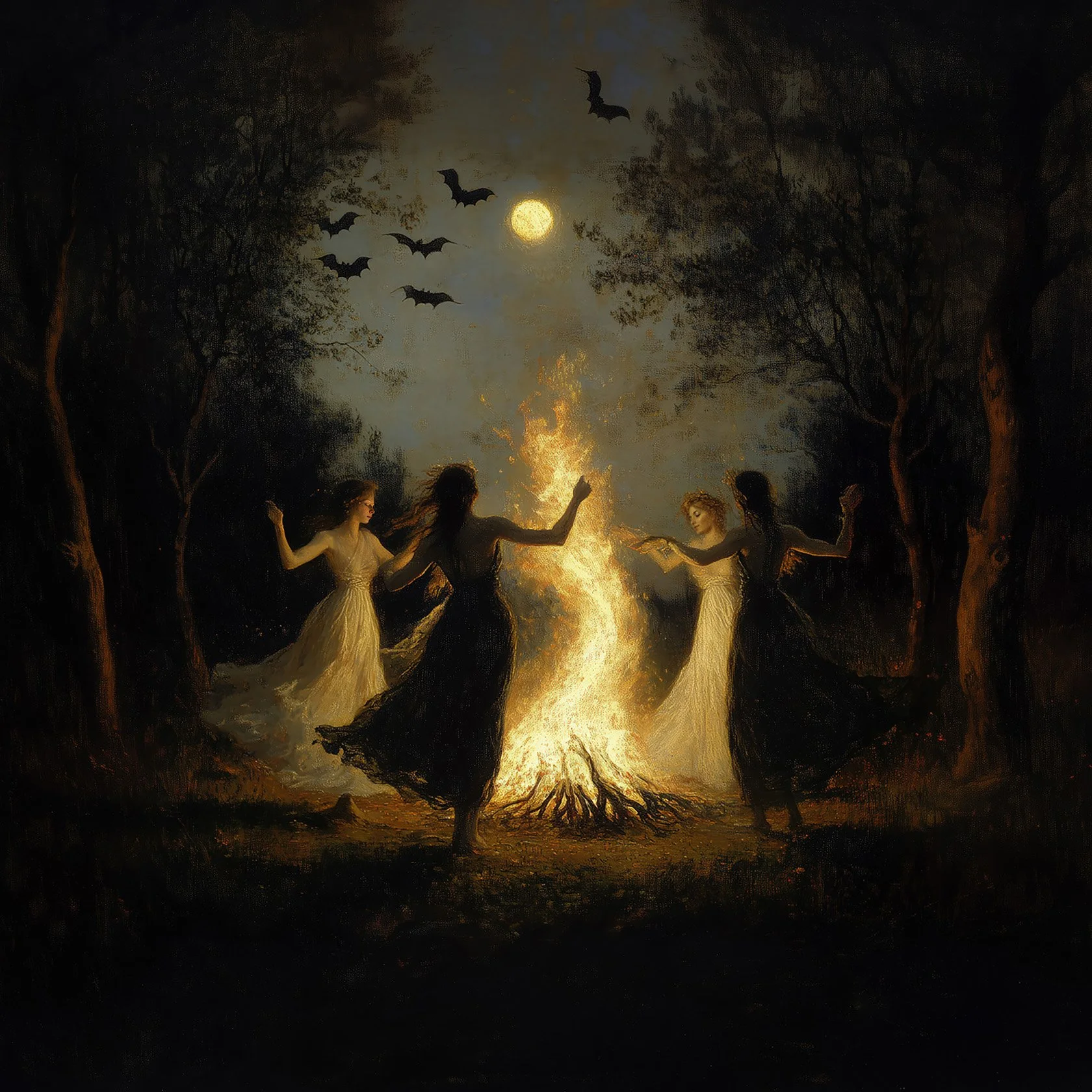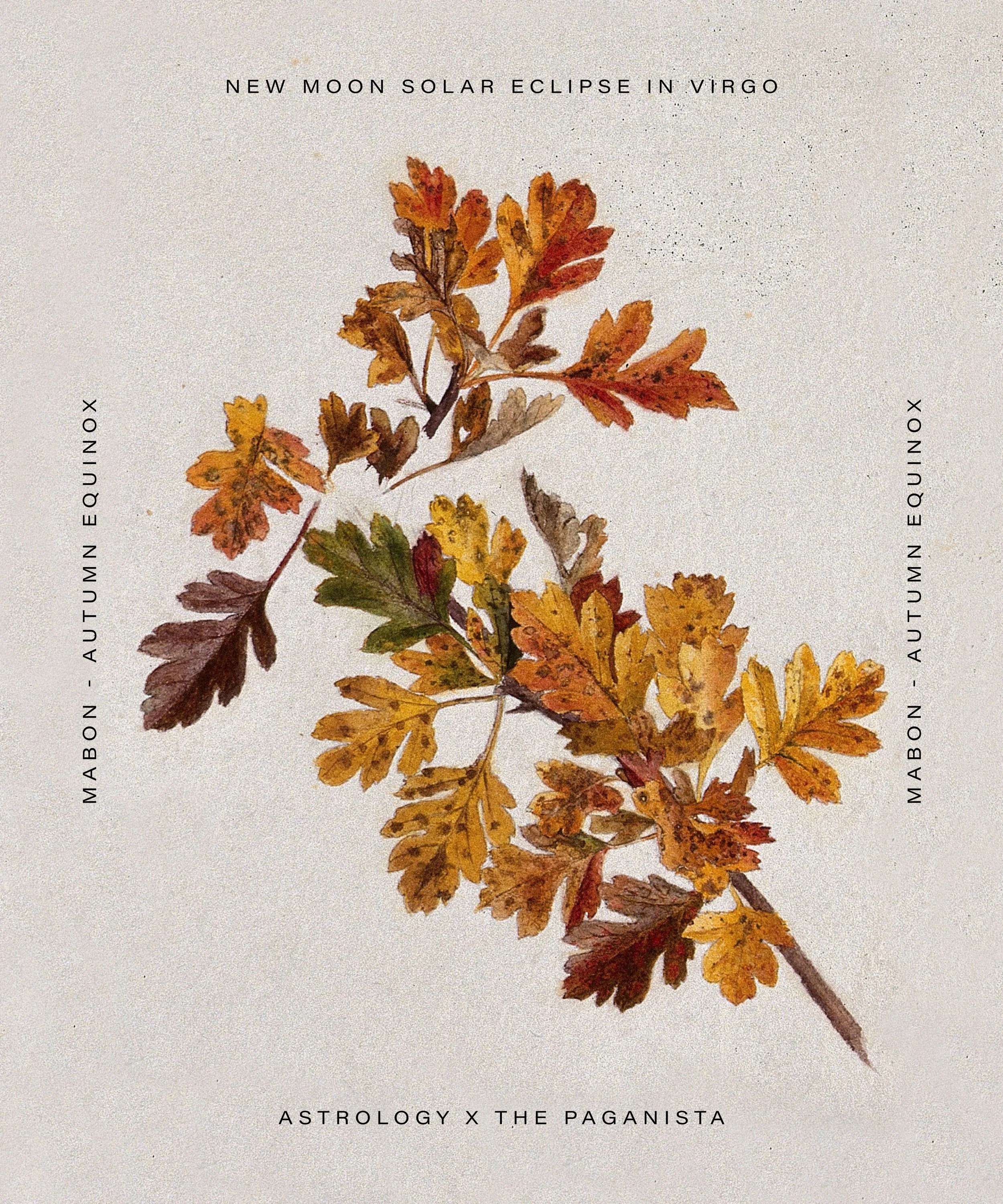Samhain
Halloween, a beloved holiday marked by costumes, candy, and eerie decorations, has a rich and multi-cultural history. It traces back to the Celtic festival of Samhain, celebrating the end of harvest and the thinning of the veil between the living and the dead. As Roman and Christian traditions merged with Samhain, the holiday evolved into All Hallows' Eve, eventually becoming Halloween. In America, it transformed further with the blend of various immigrant traditions, giving rise to the modern celebration we cherish today.
New Moon in Libra
The New Moon on October 21st arrives at the final degrees of Libra, closing the eclipse portal and opening a new cycle. At its heart, this lunation is about conscious relating — finding balance between self and other, and choosing connection rooted in truth instead of illusion. With an exact opposition to Chiron in Aries, squares to Jupiter and Pluto, and the pressure of a rare Yod, the cosmos is asking us to examine the patterns that keep us off balance. Two days later the Sun enters Scorpio, adding depth to Libra’s call for harmony. This New Moon invites us to reset, rebalance, and begin again with clarity.
Mabon, Autumn Equinox and a New Moon Solar Eclipse
The final eclipse of the year coincides with Mabon, the Fall Equinox, bringing a potent moment of balance, reflection, and release. This Partial Solar Eclipse in Virgo, on the South Node, invites us to declutter our lives, let go of unproductive habits, and reset our routines. As the Moon moves into Libra shortly after, we are called to bring harmony, fairness, and intention into our relationships and communities. Combining Equinox, Mabon, New Moon, and eclipse energies, this threshold moment encourages both personal and collective recalibration. It’s a time to honor what we’ve harvested, release what no longer serves, and step consciously into the next chapter of the year.
New Moon in Virgo
On August 23rd, the Virgo New Moon arrives as both Sun and Moon cross into Virgo, marking not just a seasonal threshold, but a spiritual one. This lunation is especially potent—falling at a critical degree, and as the first of two Virgo New Moons in succession, it amplifies themes of recalibration, service, and healing. Virgo’s energy asks us to clear what no longer supports us, refine the habits that sustain us, and return to rhythm rather than perfection.
Ostara
Rooted in ancient Germanic traditions, this festival honors the goddess Eostre, whose symbols of hares and eggs herald fertility and rebirth. Marking the vernal equinox, Ostara invites us to embrace the equilibrium of light and dark, sow seeds of intention, and awaken to the blossoming potential within and around us.
Imbolc
Imbolc, celebrated around February 1st, marks a pivotal point in the Wheel of the Year, symbolizing renewal, purification, and the returning light as winter wanes. As we embrace the growing warmth and light, Imbolc invites us to cleanse and prepare for the new life that spring promises, reflecting the enduring cycle of nature.
The Winter Solstice
Marking the longest night of the year, the Winter Solstice is a celebration of rebirth and the return of light. This sacred time invites introspection and renewal, honoring the cyclical nature of life and the promise of new beginnings.
Samhain New Moon
As the veil thins on Samhain’s sacred night, the New Moon in Scorpio calls us into the depths of transformation. In the stillness of this dark moon, we honor the cycles of death and rebirth, connecting with ancestral wisdom and uncovering the hidden truths within ourselves. Let this be a time of introspection, release, and the alchemical process of turning wounds into wisdom
Midsummer | The Wheel of the Year
Happy Midsummer/Litha/Summer Solstice! The longest day and shortest night of the year, the Summer Solstice, is a time of celebration, reflection, and reverence. Across cultures and centuries, this radiant day has marked the zenith of the sun's power, symbolizing growth, abundance, and the triumph of light over darkness. Yet, it also serves as a reminder of the inevitable descent into shadow, inviting introspection and the embrace of life's dualities. As we honor this powerful moment, let the warmth of the sun energize your spirit, and the encroaching shadows guide you toward deeper self-discovery and growth.
Beltane | The Wheel of the Year
Beltane, celebrated on May 1st, is an ancient Celtic festival marking the beginning of summer and the height of spring’s fertility. As one of the four major Gaelic seasonal festivals, it traditionally honored the blossoming of life and the potency of the natural world. Central to Beltane were large bonfires, believed to purify and protect, with rituals such as driving cattle between the flames to safeguard livestock and ensure prosperity. Communities adorned their homes with May flowers and danced around the Maypole, symbolizing the intertwining of masculine and feminine energies. Today, Beltane continues to be celebrated by modern pagans and nature enthusiasts, serving as a vibrant reminder of our deep connection to the Earth’s cycles and the enduring spirit of renewal.
Yule and the Winter Solstice
Yule, rooted in ancient Germanic and Norse traditions, marks the winter solstice around December 21st, celebrating the longest night and the return of light. The festival involves symbolic customs such as the Yule log, which represents continuity and rebirth, and is honored through feasting, wassailing, and gift-giving. Evergreen trees, a Yule tradition, evolved into the modern Christmas tree, and the Yule log’s symbolism continues in the Yule log cake and festive decorations. Today, Yule remains a period of spiritual reflection and celebration, emphasizing the triumph of light over darkness.
The Haunting History of Halloween
Halloween, a beloved holiday marked by costumes, candy, and eerie decorations, has a rich and multi-cultural history. It traces back to the Celtic festival of Samhain, celebrating the end of harvest and the thinning of the veil between the living and the dead. As Roman and Christian traditions merged with Samhain, the holiday evolved into All Hallows' Eve, eventually becoming Halloween. In America, it transformed further with the blend of various immigrant traditions, giving rise to the modern celebration we cherish today.
Mabon
Mabon: Mabon, occurring around the autumnal equinox, marks the transition from summer to fall and symbolizes balance and reflection. Named after the Welsh mythological figure Mabon ap Modron, this period echoes themes of harvest and the underworld. Though a modern term, Mabon aligns with ancient harvest celebrations and is observed globally through various festivals, such as the Moon Festival in Asia and Michaelmas in the Christian calendar. This time is a poignant reminder of nature’s cycles and the balance between light and darkness.
Lugh
Lugh, a central figure in Celtic mythology, is known for his diverse skills and attributes. As a member of the Tuatha Dé Danann and the grandson of the Fomorian leader Balor, Lugh's birth was prophesied to bring prosperity and overthrow his grandfather. His mastery across various disciplines—warfare, poetry, music, and druidic arts—earned him the title Samildánach, or Master of All Arts. Celebrated during Lughnasadh, his harvest festival in August, Lugh's legacy continues to inspire modern earth-centered spiritual practices, embodying light, knowledge, and creativity.
Lughnasadh
Lughnasadh, also known as Lammas, is celebrated on August 1st or the first harvest Full Moon, marking the start of the harvest season. Named after the Irish god Lugh, it honors his foster mother Tailtiu, who sacrificed herself to prepare the fields for cultivation. This ancient Celtic festival highlights the connection between agricultural cycles and communal celebrations, featuring feasts, games, and gatherings. In modern practices, Lughnasadh is a time for gratitude, reflection, and reconnecting with nature, while its influence also extends to Christian traditions as Lammas, celebrating the first wheat harvest and the offering of bread.















